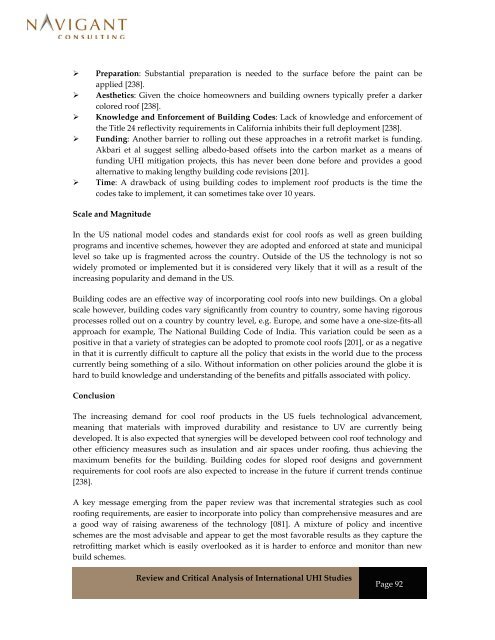Review and Critical Analysis of International UHI Studies
Review and Critical Analysis of International UHI Studies
Review and Critical Analysis of International UHI Studies
You also want an ePaper? Increase the reach of your titles
YUMPU automatically turns print PDFs into web optimized ePapers that Google loves.
� Preparation: Substantial preparation is needed to the surface before the paint can be<br />
applied [238].<br />
� Aesthetics: Given the choice homeowners <strong>and</strong> building owners typically prefer a darker<br />
colored ro<strong>of</strong> [238].<br />
� Knowledge <strong>and</strong> Enforcement <strong>of</strong> Building Codes: Lack <strong>of</strong> knowledge <strong>and</strong> enforcement <strong>of</strong><br />
the Title 24 reflectivity requirements in California inhibits their full deployment [238].<br />
� Funding: Another barrier to rolling out these approaches in a retr<strong>of</strong>it market is funding.<br />
Akbari et al suggest selling albedo‐based <strong>of</strong>fsets into the carbon market as a means <strong>of</strong><br />
funding <strong>UHI</strong> mitigation projects, this has never been done before <strong>and</strong> provides a good<br />
alternative to making lengthy building code revisions [201].<br />
� Time: A drawback <strong>of</strong> using building codes to implement ro<strong>of</strong> products is the time the<br />
codes take to implement, it can sometimes take over 10 years.<br />
Scale <strong>and</strong> Magnitude<br />
In the US national model codes <strong>and</strong> st<strong>and</strong>ards exist for cool ro<strong>of</strong>s as well as green building<br />
programs <strong>and</strong> incentive schemes, however they are adopted <strong>and</strong> enforced at state <strong>and</strong> municipal<br />
level so take up is fragmented across the country. Outside <strong>of</strong> the US the technology is not so<br />
widely promoted or implemented but it is considered very likely that it will as a result <strong>of</strong> the<br />
increasing popularity <strong>and</strong> dem<strong>and</strong> in the US.<br />
Building codes are an effective way <strong>of</strong> incorporating cool ro<strong>of</strong>s into new buildings. On a global<br />
scale however, building codes vary significantly from country to country, some having rigorous<br />
processes rolled out on a country by country level, e.g. Europe, <strong>and</strong> some have a one‐size‐fits‐all<br />
approach for example, The National Building Code <strong>of</strong> India. This variation could be seen as a<br />
positive in that a variety <strong>of</strong> strategies can be adopted to promote cool ro<strong>of</strong>s [201], or as a negative<br />
in that it is currently difficult to capture all the policy that exists in the world due to the process<br />
currently being something <strong>of</strong> a silo. Without information on other policies around the globe it is<br />
hard to build knowledge <strong>and</strong> underst<strong>and</strong>ing <strong>of</strong> the benefits <strong>and</strong> pitfalls associated with policy.<br />
Conclusion<br />
The increasing dem<strong>and</strong> for cool ro<strong>of</strong> products in the US fuels technological advancement,<br />
meaning that materials with improved durability <strong>and</strong> resistance to UV are currently being<br />
developed. It is also expected that synergies will be developed between cool ro<strong>of</strong> technology <strong>and</strong><br />
other efficiency measures such as insulation <strong>and</strong> air spaces under ro<strong>of</strong>ing, thus achieving the<br />
maximum benefits for the building. Building codes for sloped ro<strong>of</strong> designs <strong>and</strong> government<br />
requirements for cool ro<strong>of</strong>s are also expected to increase in the future if current trends continue<br />
[238].<br />
A key message emerging from the paper review was that incremental strategies such as cool<br />
ro<strong>of</strong>ing requirements, are easier to incorporate into policy than comprehensive measures <strong>and</strong> are<br />
a good way <strong>of</strong> raising awareness <strong>of</strong> the technology [081]. A mixture <strong>of</strong> policy <strong>and</strong> incentive<br />
schemes are the most advisable <strong>and</strong> appear to get the most favorable results as they capture the<br />
retr<strong>of</strong>itting market which is easily overlooked as it is harder to enforce <strong>and</strong> monitor than new<br />
build schemes.<br />
<strong>Review</strong> <strong>and</strong> <strong>Critical</strong> <strong>Analysis</strong> <strong>of</strong> <strong>International</strong> <strong>UHI</strong> <strong>Studies</strong><br />
Page 92


